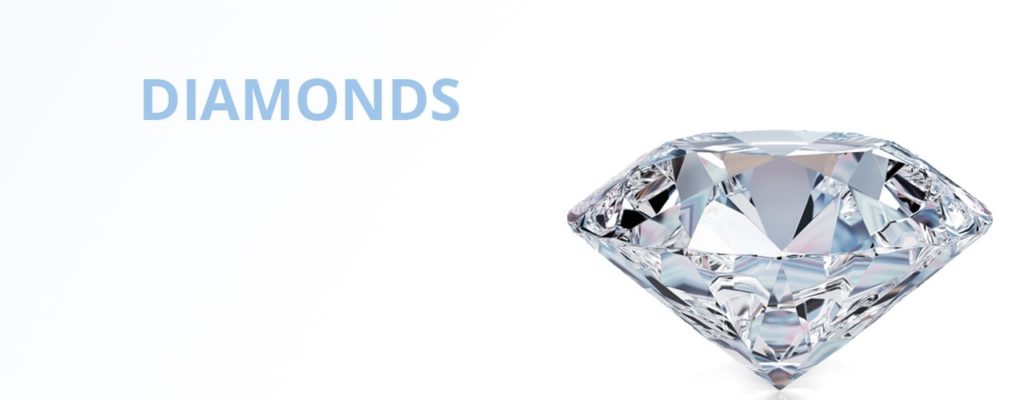
Diamonds
[vc_row][vc_column][ultimate_heading main_heading=”DIAMONDS” spacer=”line_with_icon” spacer_position=”bottom” line_height=”1″ icon_type=”custom” icon_img=”id^22275|url^https://jforever.gurucloud.co.uk/wp-content/uploads/2017/05/soliitare-ring.jpg|caption^null|alt^null|title^soliitare-ring|description^null” img_width=”150″]the 4c’s – how diamonds are graded[/ultimate_heading][vc_column_text el_class=”lead”]
When shopping for diamond set jewellery you’ll often hear mentioned the 4C’s, which is shorthand for cut, colour, clarity and carat (weight) of a diamond. A basic understanding of these 4 parameters will help you to understand how the cost of a diamond is derived and it’s impact on the overall price of a piece of jewellery. With regard wedding jewellery, arguably, the 4C’s applies more to an Engagement Ring than a Diamond Set Wedding Ring or Band. The reasoning being the wedding ring should compliment and not detract or overshadow the look of the Engagement Ring. In this respect, colour is important when considering the Wedding Band so that it matches the look of the engagement ring.
[/vc_column_text][/vc_column][/vc_row][vc_row][vc_column][vc_custom_heading text=”Diamond CUT” font_container=”tag:h3|text_align:left” use_theme_fonts=”yes”][vc_column_text]Nothing is more important to the brilliance and sparkle of a diamond than its cut, as it is responsible for around 40% of a diamond’s price. A well cut diamond will reflect light from one facet to another and back through the top, creating a dramatic sparkling effect that only a diamond can emit.[/vc_column_text][vc_row_inner][vc_column_inner width=”1/3″][vc_single_image image=”11937″ img_size=”medium”][vc_custom_heading text=”A well cut gem maximises the light reflected through its top” font_container=”tag:p|text_align:left” use_theme_fonts=”yes”][/vc_column_inner][vc_column_inner width=”1/3″][vc_single_image image=”11942″ img_size=”medium”][vc_custom_heading text=”Too shallow a cut and light will pass straight through the diamond” font_container=”tag:p|text_align:left” use_theme_fonts=”yes”][/vc_column_inner][vc_column_inner width=”1/3″][vc_single_image image=”11941″ img_size=”medium”][vc_custom_heading text=”Too deep a cut will result in light being reflected through the sides” font_container=”tag:p|text_align:left” use_theme_fonts=”yes”][/vc_column_inner][/vc_row_inner][/vc_column][/vc_row][vc_row][vc_column][vc_custom_heading text=”Diamond COLOUR” font_container=”tag:h3|text_align:left” use_theme_fonts=”yes”][vc_column_text]When jewellers refer to a diamond’s colour, they are referring to the presence or absence of colour in white diamonds. Colour is a result of the composition of the diamond, and it never changes over time.
Because a colourless diamond, like a clear glass, allows more light to pass through it than a coloured diamond, colourless diamonds emit more sparkle and fire. The formation process of a diamond ensures that only a few, very rare diamonds are truly colourless, hence, the whiter a diamond’s colour, the greater its value.[/vc_column_text][/vc_column][/vc_row][vc_row][vc_column width=”1/2″][vc_single_image image=”11939″ img_size=”full” alignment=”center” onclick=”link_image”][/vc_column][vc_column width=”1/2″][vc_custom_heading text=”Colour Grading” font_container=”tag:h3|text_align:left” use_theme_fonts=”yes”][vc_column_text]Diamonds are graded on a colour scale which was set-up by the Gemological Institute of America (GIA). This scale ranges from D (colourless) to Z. To the left is the official colour grading scale – running in order of rarity from colourless at the top to light yellow at the bottom. The price difference between two adjacent colour grades can be significant.
Colour is a personal choice. Some people like a diamond with an ice-cold whiteness (colourless or near-colourless), while others prefer the golden glow of a warmer colour. Diamonds with no colour like D, E, F, are very rare and are more expensive than near-colourless (G, H, I, J) diamonds. Diamonds with a faint tinge of colour (K, L, M, N, O) have a slightly warm colour and are more affordable. So, selecting diamonds with a lower colour grade may be the best option for those on a budget who want a larger diamond.[/vc_column_text][/vc_column][/vc_row][vc_row][vc_column][vc_custom_heading text=”Diamond CLARITY” font_container=”tag:h3|text_align:left” use_theme_fonts=”yes”][vc_column_text]Diamonds are crystallised carbon, formed in the earth under extreme pressure and high temperature. During the crystallisation process, traces of non-crystallised materials are trapped within the diamond and these ‘imperfections’ are known as inclusions. The majority of diamonds exhibit inclusions (birthmarks) and the smaller and fewer these marks are the more clean or clear the diamond is, the higher its clarity. It follows that clarity is a grading of inclusions within a diamond, the higher the clarity the rarer the diamond (very few flawless diamonds are found in nature) and by definition, more valuable.[/vc_column_text][vc_row_inner][vc_column_inner width=”1/2″][vc_column_text]Inclusions are ranked on a scale of perfection established by the Gemological Institute of America (GIA). This scale ranges from Flawless (F) to Included (I) based on the visibility of inclusions at a magnification of 10 times. Jewellers use a tool called a Loupe which allows a diamond to be viewed at 10 times its size.
Clarity is arguably the most important factor affecting the quality and price of any diamond, since the higher the clarity the more light can pass through the diamond (unhindered) making the diamond more brilliant. However, contrary to popular belief, higher clarity does not always mean more beautiful. If the inclusions are not visible to the naked eye, a higher clarity does not really improve the appearance of a diamond but rather its rarity and price.[/vc_column_text][vc_custom_heading text=”Diamond Presentation” font_container=”tag:h3|text_align:center|color:%23000000″ use_theme_fonts=”yes”][ultimate_modal modal_title=”Presentation” modal_on=”image” btn_img=”id^11946|url^https://jforever.gurucloud.co.uk/wp-content/uploads/2017/05/giphy-downsized.gif|caption^null|alt^null|title^giphy-downsized|description^null” modal_size=”block” modal_style=”overlay-show-genie” overlay_bg_color=”#0088cc” overlay_bg_opacity=”80″][/ultimate_modal][/vc_column_inner][vc_column_inner width=”1/2″][vc_single_image image=”11938″ img_size=”full” alignment=”center” onclick=”link_image”][vc_custom_heading text=”Diamond CARET” font_container=”tag:h3|text_align:left” use_theme_fonts=”yes”][vc_column_text]Derived from Greek, caret is the unit of weight used for gemstones. One carat is equal to 0.2g, therefore 5 carats equal 1g. Commonly the carat is expressed in points, a decimal or fraction. There are 100 points in a carat so, for instance, 0.5 carats can be expressed as 50 points or 1/2 of a carat or 0.5 caret.[/vc_column_text][/vc_column_inner][/vc_row_inner][/vc_column][/vc_row][vc_row][vc_column][vc_separator border_width=”3″ css_animation=”fadeIn” style=”shadow”][/vc_column][/vc_row]

